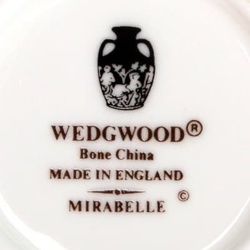
Основание фабрики - 1769 год.
В развитии изящного фарфора сыграл выдающуюся роль англичанин Джосия Веджвуд (1730—1795). Он происходил из семьи, занимавшейся гончарным делом в Стаффордшире в течение многих поколений, и посвятил этой профессии всю свою жизнь. Он был автором целого ряда усовершенствований в гончарной технике, и между иными — изобретения пирометра, дающего возможность точно измерять температуру обжига керамики. Однако он заслужил всемирную славу как создатель новых, не известных дотоле керамических масс. Свои открытия он сделал на фабрике «Этрурия» около Ньюкасла, которая ему принадлежала. Восхищенный красотой китайских красных керамических глин, он создал, соединяя глины с разной окраской, массы, похожие по виду на агат, мрамор и черепаший панцирь. Изделия, выработанные из этих смесей, имели натуральные прожилки (а не нарисованные на поверхности, как это делали до тех пор). Добавляя порошкообразный базальт, он получил очень черную массу, которая потом стала называться базальтовой. В 1781 году ему удалось получить керамическое вещество, похожее по структуре на фарфор и подкрашенное окислами металлов. Но в подлинном смысле это не были фарфор или керамическая глина. Эту массу называют фарфором Веджвуда. Очень эффектно выглядели изделия синего цвета в широкой шкале тонов — от светло-голубого до темно-синего.
Такие изделия называли яшмовыми. Веджвуд придумывал и другие подкраски массы - розовые, желтые, серо- зеленые или лиловые. Как правило, изделия Веджвуда не глазуровались, а покрывались рельефом в виде камеи, чаще всего белого цвета. Декорирование было в классическом стиле, похожем на старинный по форме и тематике. Из черной базальтовой массы делались копии античных ваз и бюсты. Веджвуд выпускал также чайные и кофейные сервизы и вазы, декорированные уже упоминавшимся рельефом. Кроме посуды на фабрике Веджвуда делали множество других предметов: статуэтки, камеи, бижутерию и плакетки для украшения мебели и стен. В польских собраниях есть овальная камея из яшмовой керамики с изображением головы короля Августа Понятовского.
Веджвуд усовершенствовал фаянсовую массу, что позволило производить посуду с тонкими стенками. Он
назвал ее «посудой королевы». Именно из нее в 1774 году был сделан знаменитый сервиз для царицы Екатерины II, состоящий из двухсот пятидесяти двух предметов, декорированных по старинным гравюрам. В некоторые периоды фабрика выпускала также костяной фарфор.
С Веджвудом сотрудничали знаменитые художники, передававшие ему узоры и модели. Среди них наиболее известным был скульптор Джон Флаксман (1755-1826). Более всего ценятся изделия, выполненные при жизни Джосии Веджвуда, то есть до 1795 года, а также в период управления фабрикой его сыном.
На рубеже XVIII-XIX веков стиль изделий Веджвуда переняли почти все тогдашние европейские фабрики. В Польше такие изделия выпускали в Рацибуже и Цмелюве.







